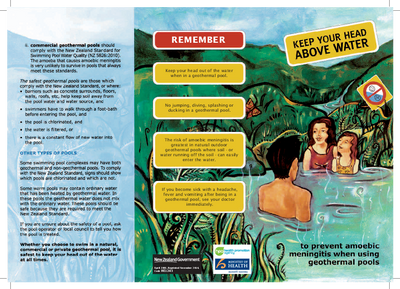Keep Your Head above Water HE1243

Most meningitis is caused by bacteria or viruses, but amoebic meningitis is caused by an amoeba that lives in hot pools. This pamphlet describes how to protect yourself by keeping your head above water in geothermal pools.
The full resource:
Keep your head above water to prevent amoebic meningitis when using geothermal pools
Keeping your head above water in a geothermal pool will protect you from amoebic meningitis.
What is amoebic meningitis?
Amoebic meningitis is a very serious illness that almost always ends in death. It is caused by a tiny organism called an amoeba which can live in geothermal pools. The amoeba can be picked up through the nose when a person puts their head under water in a geothermal pool.
Fortunately amoebic meningitis is very rare in Aotearoa New Zealand.
Geothermal pools
Geothermal pools contain geothermal water – that is, warm water that comes from the earth in geothermal regions like Taupo, Rotorua and some other parts of the country.
Geothermal water can be found in natural outdoor pools, and in commercial pools such as public swimming pools or spas in hotels, motels, health centres and gyms. Some geothermal pools can be found in private homes.
How does amoebic meningitis differ from other types of meningitis?
All types of meningitis are serious. Unlike other types of meningitis (eg, meningitis caused by bacteria or viruses), amoebic meningitis cannot be passed from person to person. However, amoebic meningitis is more serious because treatment is not usually successful. With other types of meningitis early treatment can save lives.
Most meningitis is caused by bacteria or viruses. Even meningitis that occurs after swimming in a geothermal pool is most likely to be caused by a bacteria or virus, rather than the amoeba. Only a hospital test can show what type of meningitis is present.
Early symptoms of all types of meningitis are:
- headache
- fever
- vomiting.
Symptoms of amoebic meningitis usually start 3 – 7 days after swimming in a geothermal pool. If you have these symptoms see your doctor immediately.
How is amoebic meningitis passed on to people?
The amoeba usually lives in warm soil. It can get into geothermal pools when soil is:
- in direct contact with the pool, eg, in a pool that is not concrete-lined, or
- washed into a geothermal pool by rain, or
- blown into the pool by wind, or
- carried into the pool on people’s feet.
If the pool is not chlorinated (that is, not treated with chemicals to kill organisms), the amoeba can survive in the geothermal water.
When a person puts their head under water, the amoeba can, in rare cases, enter the nose and travel along the nerves to the brain. The amoeba then invades the brain causing swelling and death.
The risk of the amoeba getting to the brain is much greater if the water is forced up the nose, eg, when a person jumps or dives into the water.
You can enjoy geothermal pools safely by:
-
keeping your head above the water at all times.
Do not put your head under the water for any reason. Never jump, dive, splash or duck in the pool as this forces water up the nose. -
choosing your geothermal pool carefully.
When choosing a pool, remember:-
natural outdoor pools do not have to meet safety
standards. This means that the amoeba can survive in these pools.
The risk of amoebic meningitis is highest in natural geothermal pools where soil is in direct contact with water, or where soil – or water running off the soil – can easily spill into the pool. - commercial geothermal pools should comply with the New Zealand Standard for Swimming Pool Water Quality (NZ 5826:2000). The amoeba that causes amoebic meningitis is very unlikely to survive in pools that always meet these standards.
-
natural outdoor pools do not have to meet safety
standards. This means that the amoeba can survive in these pools.
The safest geothermal pools are those which comply with the New Zealand Standard, or where:
- barriers such as concrete surrounds, floors, walls, roofs, etc, help keep soil away from the pool water and water source, and
- swimmers have to walk through a foot-bath before entering the pool, and
- the pool is chlorinated, and
- the water is filtered, and
- there is a constant flow of new water into the pool.
Other types of pools
Some swimming pool complexes may have both geothermal and non-geothermal pools. To comply with the New Zealand Standard, signs should show which pools are chlorinated and which are not.
Some warm pools may contain ordinary water that has been heated by geothermal water. In these pools the geothermal water does not mix with the ordinary water. These pools should be safe because they are required to meet the New Zealand Standard.
If you are unsure about the safety of a pool, ask the pool operator or local council to tell you how the pool is treated.
Whether you choose to swim in a natural, commercial or private geothermal pool, it is safest to keep your head out of the water at all times.
Remember
Keep your head out of the water when in a geothermal pool.
No jumping, diving, splashing or ducking in a geothermal pool.
The risk of amoebic meningitis is greatest in natural outdoor geothermal pools where soil – or water running off the soil – can easily enter the water.
If you become sick with a headache, fever and vomiting after being in a geothermal pool, see your doctor immediately.